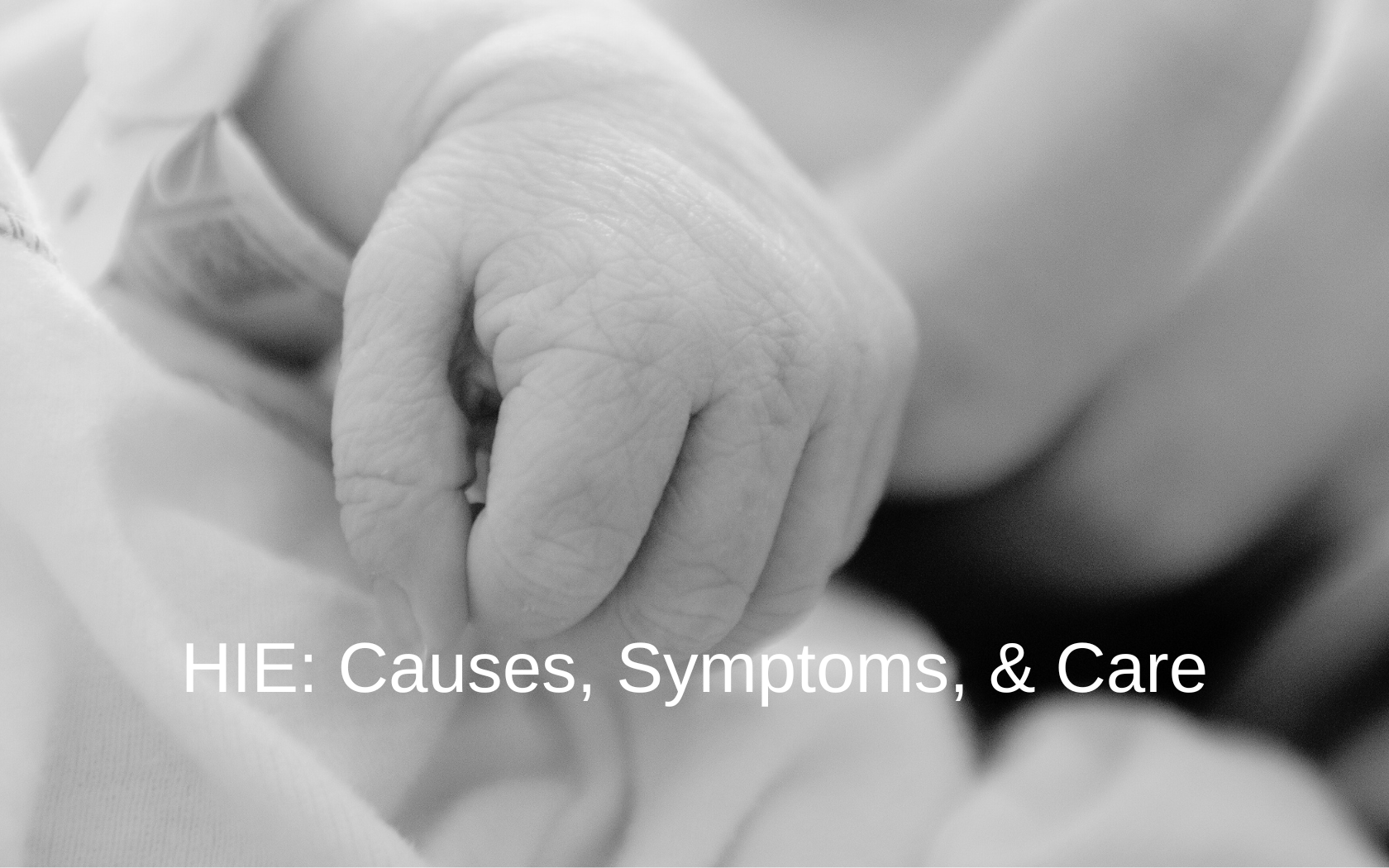What is HIE in newborns? It would be wonderful if those letters stood for “healthy in excess”. But it actually stands for hypoxic-ischemic encephalopathy. It’s a brain condition that occurs in 3-20 per 1000 live births, according to UF Health.
Below, we’ll dive into what could cause an HIE diagnosis at birth, plus symptoms and prognosis for this condition.

What is HIE in Newborns?
Hypoxic-Ischemic Encephalopathy (HIE) in newborns is a serious condition where a baby’s brain doesn’t get enough oxygen and blood flow around the time of birth. HIE can damage brain cells or cause them to die. This can result in various health problems, like seizures and cerebral palsy.
What Causes HIE in Newborns?
Many different complications can lead to an HIE diagnosis at birth, such as:
- Problems with the umbilical cord: If the cord gets wrapped around the baby’s neck or is compressed, it can restrict blood flow.
- Issues with the placenta: If the placenta detaches too early from the uterus (placental abruption), it can cut off the baby’s oxygen supply.
- Maternal health issues: Severe blood pressure problems or infections in the mother can affect the baby’s oxygen supply.
- Prolonged labor: A very long or difficult labor can sometimes lead to oxygen deprivation.
- Traumatic delivery: Difficult births involving forceps or vacuum extraction can cause trauma and reduced oxygen.
In many cases, the issues that lead to HIE in newborns aren’t preventable. Other times, HIE develops because health care providers make errors or fail to pay attention to early symptoms of oxygen deprivation. If you suspect that’s what occurred during your child’s birth, contact our birth injury lawyers to find out if you have a case.

Symptoms of HIE in Newborns
The symptoms of HIE can vary. But they often include:
- Floppiness, weak reflexes
- Being unusually sleepy, irritable, or unresponsive
- Trouble breathing
- Seizures
- Difficulty feeding
- Pale/blue skin
- Irregular heartbeat
Symptoms of HIE aren’t always noticeable right away. That’s why it’s important to tell your doctor if you notice something unusual in the days after birth.
Doctors have an obligation to assess a baby after birth. They must check a baby’s breathing, skin color, muscle tone, heart rate and reflexes, scoring them from 0-2. This is called an Apgar score. If the score is lower than 7, the baby needs immediate medical attention.
Since most babies with HIE have a low Apgar score, this test is an essential part of making an HIE diagnosis at birth.
Prognosis for Newborns with HIE
The prognosis for one baby with HIE can be very different from that of another. It depends on three main factors:
- Whether the baby receives quick, adequate treatment after birth
- The baby’s overall health
- How severe the baby’s HIE is
There are three “levels” of severity for HIE:
- Mild HIE: Many infants recover fully with minimal or no long-term effects.
- Moderate HIE: Outcomes vary. Some infants recover well. Others may face developmental delays or learning disabilities. Early intervention helps improve outcomes.
- Severe HIE: High risk for significant long-term issues like cerebral palsy. Babies with severe HIE may have cognitive impairments, epilepsy, and sensory deficits.
Early treatment, especially therapeutic hypothermia, can improve outcomes for babies with HIE. After initial treatment, a baby can receive therapy to improve their long-term prospects.
Long-term health issues include cerebral palsy, cognitive and learning disabilities, and behavioral challenges. Most kids with HIE need continuous treatment and support. It’s essential for improving their quality of life.

My Baby Received an HIE Diagnosis at Birth: Now What?
Receiving an HIE diagnosis for your newborn can be overwhelming. Unfortunately, you can’t cure your baby’s condition. But there’s a lot you can do to help improve it.
First, make sure your baby receives appropriate medical care. Treatments like therapeutic hypothermia can improve outcomes if started within six hours of birth. Your baby may also need supportive care to stabilize vital functions and manage any seizures.
Following initial treatment, you should make appointments with pediatric neurologists and developmental specialists. These professionals will monitor your child’s progress and identify any developmental delays early on. They’ll tell you which treatments and therapies your child might benefit from the most.
Also, it’s important to explore the circumstances surrounding your baby’s birth. If you suspect that medical negligence may have contributed to the HIE diagnosis, consult with a legal professional who specializes in birth injuries. They can help you investigate the situation, understand your rights, and pursue compensation. This can provide the financial support you need to provide the best possible care for your child.
HIE in Newborns FAQs
Some babies can recover from HIE. But the extent of their recovery varies, based on several factors. HIE is a condition where the brain doesn’t get enough oxygen and blood. So recovery depends on how long oxygen deprivation went on, and how severe it was. Many babies with mild HIE suffer minimal to no long-term effects. But babies with moderate to severe HIE might experience developmental delays, physical disabilities, or other neurological issues.
According to the Cleveland Clinic, there’s a 25-50% mortality rate for infants with severe HIE, often within the first few days of life. Of those who survive, the majority develop severe and permanent conditions, such as cerebral palsy, epilepsy, and cognitive impairments.
Not all children with HIE have the same life expectancy. It varies depending on how severe their condition is. Also, having complications related to HIE can lower life expectancy.
Most children with mild HIE have a normal life expectancy. They live as long as anyone else would, though they might experience some disabilities. For children with moderate HIE, the prognosis is more variable. 25% to 75% have severe disabilities or pass away early, according to the Florida Neonatal Neurologic Network.
Severe HIE can shorten life expectancy. About 75% of these children have disabilities.
A baby with Hypoxic-Ischemic Encephalopathy (HIE) may have breathing problems, feeding difficulties, and seizures. They might be unusually sleepy or hard to wake up. Muscle tone can be either too stiff or too floppy. Reflexes, such as sucking or grasping, may be weak or absent.
Sometimes the early signs of HIE are subtle. So medical professionals use various diagnostic tools, including MRIs and EEGs, to look at a baby’s brain function and see if there’s any damage.




